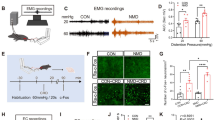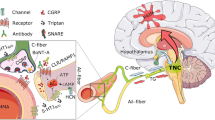Abstract
One primary goal of medical treatment of endometriosis is to alleviate pain and there is a pressing need for new therapeutics for endometriosis with better efficacy and side-effect profiles. Levo-tetrahydropalmatine (l-THP) has been used as a sedative or analgesic for chronic pains in China since 1970s. In this study, we sought to evaluate the efficacy of l-THP, with or without valproic acid (VPA), in a rat model of endometriosis. We surgically induced endometriosis in 55 adult female rats. Two weeks after, all rats were further divided into 5 groups randomly: untreated, low- and high-dose of l-THP, VPA, and l-THP + VPA. Response latency in hotplate test was measured before the surgery, before and after 3-week treatment of respective drugs. All rats were then sacrificed for analysis. The average lesion size and the immunoreactivity to N-methyl-d-asparate receptor 1 (NMDAR1), acid-sensing ion channel 3 (ASIC3), calcitonin gene-related peptide (CGRP), c-Fos, tyrosine kinase receptor A (TrkA), and histone deacetylase 2 (HDAC2) in dorsal root ganglia (DRG), to phorphorylated p65, HDAC2, TrkA, and CGRP in ectopic endometrium and to phorphorylated p65 and CGRP in eutopic endometrium were evaluated. We found that rats receiving l-THP, with or without VPA, had significantly reduced lesion size and exhibited significantly improved response to noxious thermal stimulus. The treatment also significantly lowered immunoreactivity to all mediators involved in central sensitization and to HDAC2 in DRG, to TrkA and CGRP in ectopic endometrium, and to CGRP in eutopic endometrium. In summary, l-THP reduces lesion growth and generalized hyperalgesia. Thus, l-THP may be a promising therapeutics for endometriosis.
Similar content being viewed by others
References
Olive DL, Lindheim SR, Pritts EA. New medical treatments for endometriosis. Best Pract Res Clin Obstet Gynaecol. 2004;18(2):319–328.
Giudice LC, Kao LC. Endometriosis. Lancet. 2004;364(9447):1789–1799.
Wheeler JM, Malinak LR. Recurrent endometriosis: incidence, management, and prognosis. Am J Obstet Gynecol. 1983;146(3):247–253.
Waller KG, Shaw RW. Gonadotropin-releasing hormone analogues for the treatment of endometriosis: long-term follow-up. Fertil Steril. 1993;59(3):511–515.
Kiilholma P, Tuimala R, Kivinen S, Korhonen M, Hagman E. Comparison of the gonadotropin-releasing hormone agonist goserelin acetate alone versus goserelin combined with estrogen-progestogen add-back therapy in the treatment of endometriosis. Fertil Steril. 1995;64(5):903–908.
Lessey BA. Medical management of endometriosis and infertility. Fertil Steril. 2000;73(6):1089–1096.
Bulun SE, Lin Z, Imir G, et al. Regulation of aromatase expression in estrogen-responsive breast and uterine disease: from bench to treatment. Pharmacol Rev. 2005;57(3):359–383.
Nothnick WB, D’Hooghe TM. Medical management of endometriosis: novel targets and approaches towards the development of future treatment regimes. Gynecol Obstet Invest. 2003;55(4):189–198.
Guo SW. Epigenetics of endometriosis. Mol Hum Reprod. 2009;15(10):587–607.
Lu Y, Nie J, Liu X, Zheng Y, Guo SW. Tricostatin A, a histone deacetylase inhibitor, reduces lesion growth and hyperalgesia in experimentally induced endometriosis in mice. Hum Reprod. 2010;25(4):1014–1025.
Berkley KJ, Cason A, Jacobs H, Bradshaw H, Wood E. Vaginal hyperalgesia in a rat model of endometriosis. Neurosci Lett. 2001;306(3):185–188.
Latremoliere A, Woolf CJ. Central sensitization: a generator of pain hypersensitivity by central neural plasticity. J Pain. 2009;10(9):895–926.
Hu JY, Jin GZ. Effect of tetrahydropalmatine analogs on Fos expression induced by formalin-pain. Zhongguo Yao Li Xue Bao. 1999;20(3):193–200.
Han YF, Hou LH, Zhou YJ, Wu XK. A survey of TCM treatment for endometriosis. J Tradit Chin Med. 2009;29(1):64–70.
Chu H, Jin G, Friedman E, Zhen X. Recent development in studies of tetrahydroprotoberberines: mechanism in antinociception and drug addiction. Cell Mol Neurobiol. 2008;28(4):491–499.
Hu JY, Jin GZ. Supraspinal D2 receptor involved in antinociception induced by l-tetrahydropalmatine. Zhongguo Yao Li Xue Bao. 1999;20(8):715–719.
Wang GL, Zhu L. Effects of l-tetrahydropalmatine on contraction of isolated rat uterus [Zuo xuan si qing ba ma ting dui da shu li ti zi gong shou suo fan ying de ying xiang in Chinese]. Pharmacol Clin Chinese Materia Medica. 2005;21(2):14–16.
Xu JD, Wang W, Yang HX, Li ZQ, Ma LY, Hou XL. Inhibitive effect of tetrahydropalmatine on contractile activity of uterine smooth muscle strips in virginal rats [Yan Hu Suo dui wei yun da shu li ti zi gong ping hua ji yun dong de yi zhi zuo yong in Chinese]. J Clin Rehabil Tissue Eng Res. 2007;11(21):4178–4181.
Zhao GJ, Ren SL, Wu SG, et al. Effect of L-THP on contraction of blood vessels induced by 5-hydroxytryptamine (in Chinese). Chin J Pharmacol Toxicol. 1988;4:342–348.
Xing JF, et al. Effects of dl tetrahydropalmation on rabbit platelet aggregation and experimental cerebral thrombosis in rats (in Chinese). Chin Pharmacol Bull. 1997;13(3):258–10.
Gao YJ, Ji RR. c-Fos and pERK, which is a better marker for neuronal activation and central sensitization after noxious stimulation and tissue injury? Open Pain J. 2009;2:11–17.
Ikeuchi M, Kolker SJ, Burnes LA, Walder RY, Sluka KA. Role of ASIC3 in the primary and secondary hyperalgesia produced by joint inflammation in mice. Pain. 2008;137(3):662–669.
Sevcik MA, Ghilardi JR, Peters CM, et al. Anti-NGF therapy profoundly reduces bone cancer pain and the accompanying increase in markers of peripheral and central sensitization. Pain. 2005;115(1–2):128–141.
Heppenstall PA, Lewin GR. Neurotrophins, nociceptors and pain. Curr Opin Anaesthesiol. 2000;13(5):573–576.
Binshtok AM, Wang H, Zimmermann K, et al. Nociceptors are interleukin-1beta sensors. J Neurosci. 2008;28(52):14062–14073.
Haddad JJ. On the enigma of pain and hyperalgesia: a molecular perspective. Biochem Biophys Res Commun. 2007;353(2):217–224.
Osborn L, Kunkel S, Nabel GJ. Tumor necrosis factor alpha and interleukin 1 stimulate the human immunodeficiency virus enhancer by activation of the nuclear factor kappa B. Proc Natl Acad Sci USA. 1989;86(7):2336–2340.
Le Bars D, Gozariu M, Cadden SW. Animal models of nociception. Pharmacol Rev. 2001;53(4):597–652.
Bannon AW, Malmberg AB. Models of nociception: hot-plate, tail-flick, and formalin tests in rodents. Curr Protoc Neurosci. 2007;Chapter 8:Unit 8.9.
Chaban VV. Visceral sensory neurons that innervate both uterus and colon express nociceptive TRPv1 and P2X3 receptors in rats. Ethn Dis. 2008;18(2 suppl 2):S2–20–4.
Inhaka R, Gentleman RR. R: a language for data analysis and graphics. J Comput Graph Statist. 1996;5:1923–1927.
Cui L, Wu T. [L-Tetrahydropalmatine enhances inhibition of cellular proliferation by Vincristine Sulfate in human leukemia cell lines]. Chin Pharmacol Bull. 1995;11(4):348.
Lagadec C, Meignan S, Adriaenssens E, et al. TrkA overexpression enhances growth and metastasis of breast cancer cells. Oncogene. 2009;28(18):1960–1970.
Kawanami Y, Morimoto Y, Kim H, et al. Calcitonin gene-related peptide stimulates proliferation of alveolar epithelial cells. Respir Res. 2009;10:8.
Ribatti D, Nico B, Perra MT, et al. Correlation between NGF/TrkA and microvascular density in human pterygium. Int J Exp Pathol. 2009;90(6):615–620.
Okajima K, Harada N. Promotion of insulin-like growth factor-I production by sensory neuron stimulation; molecular mechanism(s) and therapeutic implications. Curr Med Chem. 2008;15(29):3095–3112.
Woolf CJ, Thompson SW. The induction and maintenance of central sensitization is dependent on N-methyl-D-aspartic acid receptor activation; implications for the treatment of post-injury pain hypersensitivity states. Pain. 1991;44(3):293–299.
Sun RQ, Lawand NB, Willis WD. The role of calcitonin gene-related peptide (CGRP) in the generation and maintenance of mechanical allodynia and hyperalgesia in rats after intradermal injection of capsaicin. Pain. 2003;104(1–2):201–208.
McMahon SB. NGF as a mediator of inflammatory pain. Philos Trans R Soc Lond B Biol Sci. 1996;351(1338):431–440.
Basselin M, Chang L, Chen M, Bell JM, Rapoport SI. Chronic administration of valproic acid reduces brain NMDA signaling via arachidonic acid in unanesthetized rats. Neurochem Res. 2008;33(11):2229–2240.
Tong C, Ma W, Shin SW, James RL, Eisenach JC. Uterine cervical distension induces cFos expression in deep dorsal horn neurons of the rat spinal cord. Anesthesiology. 2003;99(1):205–211.
Stratton P, Sinaii N, Segars J, et al. Return of chronic pelvic pain from endometriosis after raloxifene treatment: a randomized controlled trial. Obstet Gynecol. 2008;111(1):88–96.
Ashburner BP, Westerheide SD, Baldwin AS Jr. The p65 (RelA) subunit of NF-kappaB interacts with the histone deacetylase (HDAC) corepressors HDAC1 and HDAC2 to negatively regulate gene expression. Mol Cell Biol. 2001;21(20):7065–7077.
Kaler P, et al. HDAC2 deficiency sensitizes colon cancer cells to TNFalpha-induced apoptosis through inhibition of NF-kappaB activity. Exp Cell Res. 2008;314(7):1507–1518.
Ma W, Bisby MA. Increased activation of nuclear factor kappa B in rat lumbar dorsal root ganglion neurons following partial sciatic nerve injuries. Brain Res. 1998;797(2):243–254.
Niederberger E, Geisslinger G. The IKK-NF-kappaB pathway: a source for novel molecular drug targets in pain therapy? Faseb J. 2008;22(10):3432–3442.
Mattson MP, Camandola S. NF-kappaB in neuronal plasticity and neurodegenerative disorders. J Clin Invest. 2001;107(3):247–254.
Chiechio S, Zammataro M, Morales ME, et al. Epigenetic modulation of mGlu2 receptors by histone deacetylase inhibitors in the treatment of inflammatory pain. Mol Pharmacol. 2009;75(5):1014–1020.
Hrzenjak A, Moinfar F, Kremser ML, et al. Valproate inhibition of histone deacetylase 2 affects differentiation and decreases proliferation of endometrial stromal sarcoma cells. Mol Cancer Ther. 2006;5(9):2203–2210.
Wu Y, Starzinsky-Powitz A, Guo SW. Constitutive and TNFα-stimulated activation of nuclear factor κB (NF-κB) in immortalized endometriotic cells and their suppression by trichostatin A (TSA). Gynecol Obstet Invest. 2010;In press.
Toth CC, Willis D, Twiss JL, et al. Locally synthesized calcitonin gene-related Peptide has a critical role in peripheral nerve regeneration. J Neuropathol Exp Neurol. 2009;68(3):326–337.
Tokushige N, Markham R, Russell P, Fraser IS. High density of small nerve fibres in the functional layer of the endometrium in women with endometriosis. Hum Reprod. 2006;21(3):782–787.
Zhang X, Lu B, Huang X, Xu H, Zhou C, Lin J. Endometrial nerve fibers in women with endometriosis, adenomyosis, and uterine fibroids. Fertil Steril. 2009;92(5):1799–1801.
Xu JD, Wang W, Yang HX, Li ZQ, Ma LY, Hou XL. Inhibitive effect of tetrahydropalmatine on contractile activity of uterine smooth muscle strips in virginal rats (in Chinese). J Clin Rehabil Tissue Eng Res. 2007;11(21):4178–4181.
Moynihan AT, Hehir MP, Sharkey AM, Robson SC, Europe-Finner GN, Morrison JJ. Histone deacetylase inhibitors and a functional potent inhibitory effect on human uterine contractility. Am J Obstet Gynecol. 2008;199(2):167.e1–167.e7.
Novella-Maestre E, Carda C, Noguera I, et al. Dopamine agonist administration causes a reduction in endometrial implants through modulation of angiogenesis in experimentally induced endometriosis. Hum Reprod. 2009;24(5):1025–1035.
Novella-Maestre E, et al. Identification and quantification of dopamine receptor 2 in human eutopic and ectopic endometrium: a novel molecular target for endometriosis therapy. Biol Reprod. 2010. [Epub ahead of print].
Ren Y. Intramuscular injuction of Rotundine cause serious allergic reactions in 2 cases [Ji Zhu lu tong ding zhi yan zhong guo min fan ying 2 li in Chinese]. Hai nan Medicine. 2001;4:41.
Tunnicliff G. Actions of sodium valproate on the central nervous system. J Physiol Pharmacol. 1999;50(3):347–365.
Johannessen CU. Mechanisms of action of valproate: a commentatory. Neurochem Int. 2000;37(2–3):103–110.
Jentink J, Loane MA, Dolk H, et al. Valproic acid monotherapy in pregnancy and major congenital malformations. N Engl J Med. 2010;362(23):2185–2193.
Liu X, Yuan L, Guo SW. Valproic acid as a therapy for adenomyosis: a comparative case series. Reprod Sci. 2010;[Epub ahead of print]
Zhang JF, et al. [Determination of Rotundine in human plasma by HPLC and pharmacokinetic studies] in Chinese. J. China Pharmaceutical Univ., 1998. 29(1): p. 67–70.
Moyer TP. Therapeutic drug monitoring. In: Burtic AC, Ashwood ER, eds. Tietz Textbook of Clinical Chemistry. Philadelphia: WB Sanders; 1999:873, 876–877.
Author information
Authors and Affiliations
Corresponding author
Rights and permissions
About this article
Cite this article
Zhao, T., Liu, X., Zhen, X. et al. Levo-Tetrahydropalmatine Retards the Growth of Ectopic Endometrial Implants and Alleviates Generalized Hyperalgesia in Experimentally Induced Endometriosis in Rats. Reprod. Sci. 18, 28–45 (2011). https://doi.org/10.1177/1933719110381928
Published:
Issue Date:
DOI: https://doi.org/10.1177/1933719110381928




